A super simple APA checklist that covers all the APA rules you need to know for your essays and dissertations.
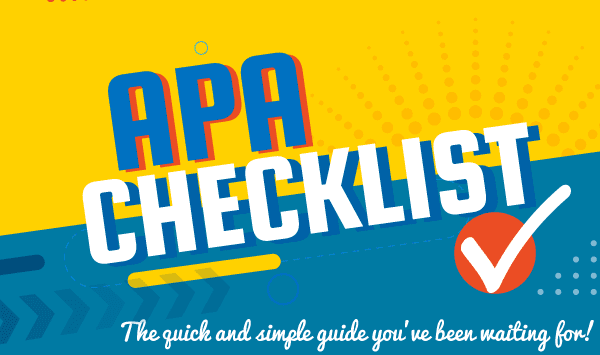
The news that an essay or dissertation has to be formatted in APA can come as a big blow to a sleep-deprived student.
It’s not enough that you have to research a paper, try and put it all together in a format that makes sense, and proofread the dastardly thing… now you are being asked to apply some cultish APA formatting rules that seem so complicated they make Steven Hawking look simple.
With so many APA rules to follow, it can be extremely challenging to make sure you have covered them all in your essay.
Seriously, just how can your professor expect you to read all these standards and apply them to format your essay correctly?
It gets worse: The official guide is updated on a regular basis, which only adds to the confusion.
Here’s some good news:
When you’re asked to write an APA essay or edit a dissertation, all you need is our handy APA checklist. Yup, for real!
We’ve trawled through all the APA rules for you and extracted the most important requirements to create this handy APA checklist.
The cherry on the cake:
It’s completely free for you to print out and keep!
Here’s a breakdown of what our APA checklist contains. You can go right ahead and jump to the section that is most relevant to you.
APA Checklist: A Really Simple Guide to APA Rules
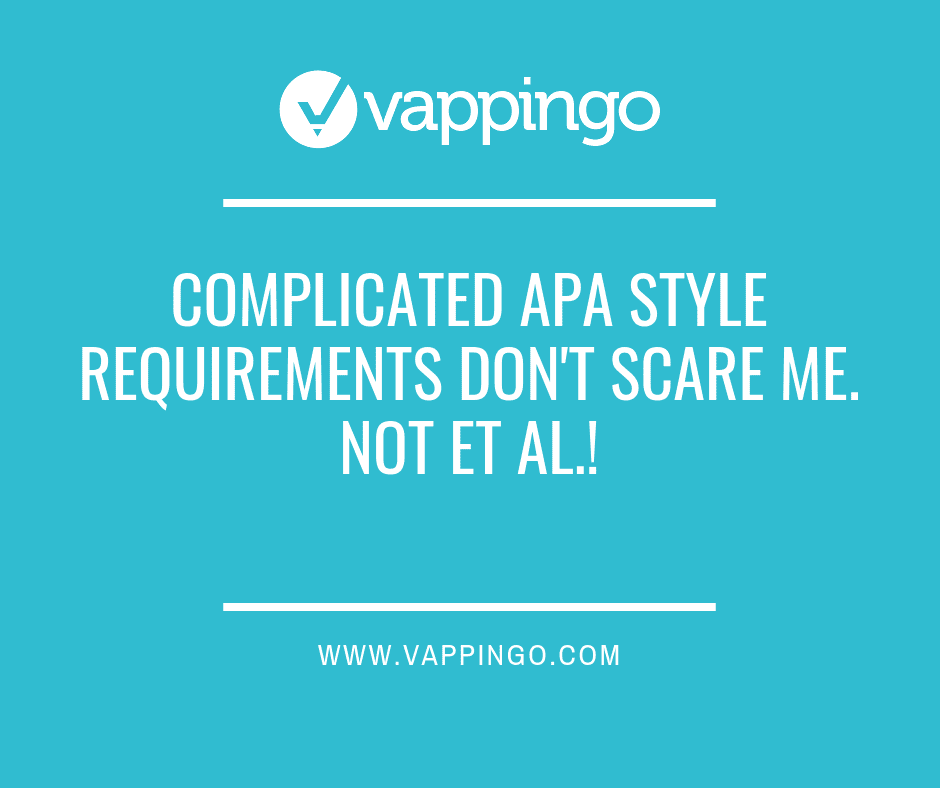
APA Rules: Title Page
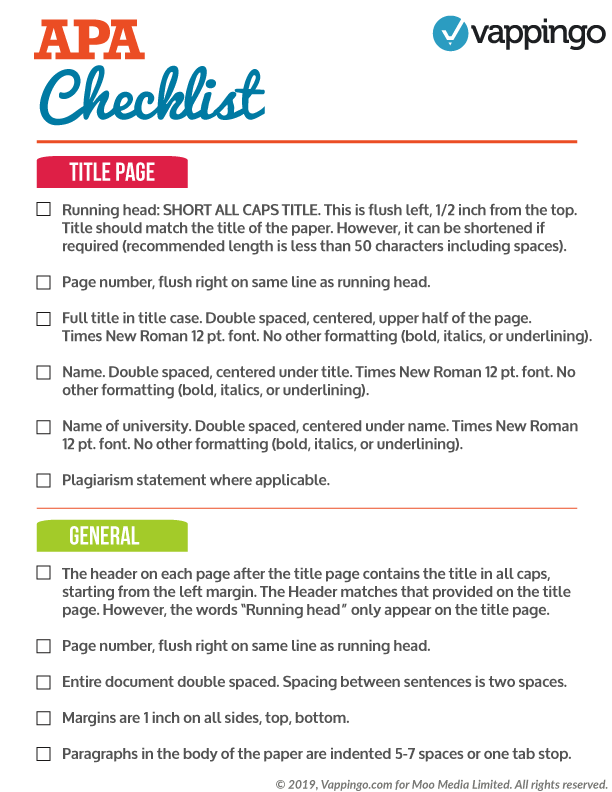
- Running head: SHORT ALL CAPS TITLE. This is flush left, 1/2 inch from the top. Title should match the title of the paper. However, it can be shortened if required (recommended length is less than 50 characters including spaces).
- Page number, flush right on the same line as running head.
- Full title in title case. Double spaced, centered, upper half of the page. Times New Roman 12 pt. font. No other formatting (bold, italics, or underlining).
- Name. Double spaced, centered under title. Times New Roman 12 pt. font. No other formatting (bold, italics, or underlining).
- Name of university. Double spaced, centered under name. Times New Roman 12 pt. font. No other formatting (bold, italics, or underlining).
- Plagiarism statement (where applicable).
APA Rules: General Requirements
- The header on each page after the title page contains the title in all caps, starting from the left margin. The Header matches that provided on the title page. However, the words “Running head” only appear on the title page.
- Page number, flush right on the same line as running head.
- Entire document double spaced.
- Spacing between sentences is two spaces.
- Margins are 1 inch on all sides, top, bottom.
- Paragraphs in the body of the paper are indented 5-7 spaces or one tab stop.
APA Rules: Headings
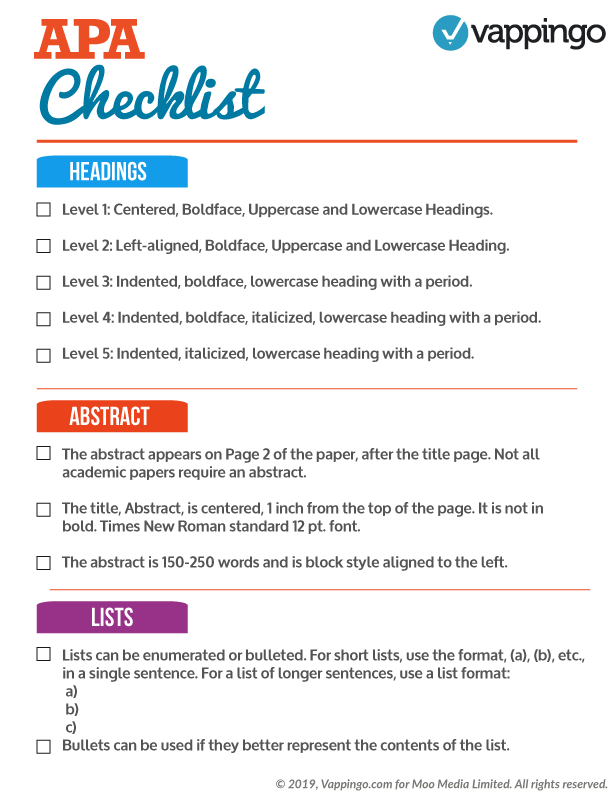
- Level 1: Centered, Boldface, Uppercase and Lowercase Headings.
- Level 2: Left-aligned, Boldface, Uppercase and Lowercase Heading.
- Level 3: Indented, boldface, lowercase heading with a period.
- Level 4: Indented, boldface, italicized, lowercase heading with a period.
- Level 5: Indented, italicized, lowercase heading with a period.
APA Rules: Abstract Page
- Not all academic papers require an abstract.
- The abstract appears on Page 2 of the paper, after the title page.
- The title, Abstract, is centered, 1 inch from the top of the page. It is not in bold. Times New Roman standard 12 pt. font. The abstract is 150-250 words and is block style aligned to the left.
APA Rules: Lists
- Lists can be enumerated or bulleted.
- For short lists, use the format, (a), (b), etc., in a single sentence. For a list of longer sentences, use a list format:
- a.
- b.
- c.
- Bullets can be used if they better represent the contents of the list.
APA Rules: In-text Citations
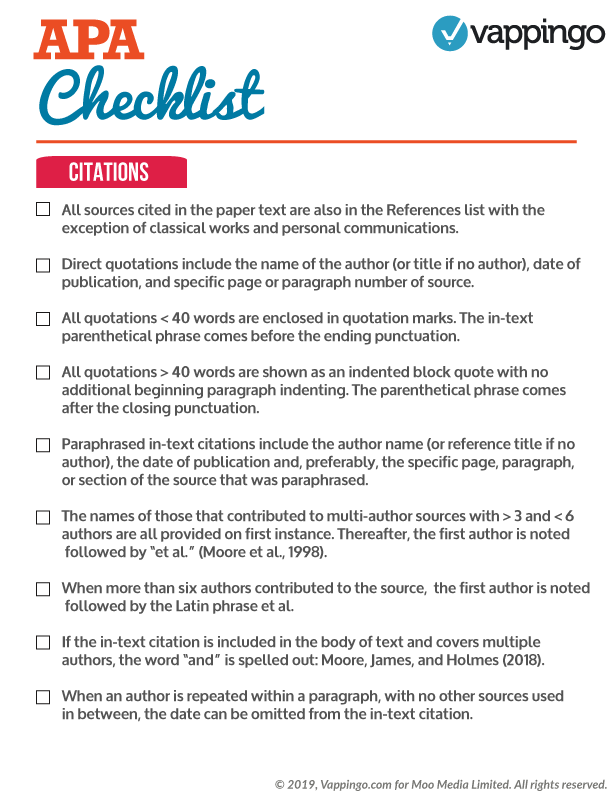
- All sources cited in the paper text are also in the “References” list with the exception of classical works and personal communications.
- Direct quotations are followed the name of the author (or title if no author), date of publication, and specific page or paragraph number of source (Moore, 2019, p.6).
- All quotations < 40 words are enclosed in quotation marks. The parenthetical phrase comes before the closing punctuation.
- All quotations > 40 words are shown as an indented block quote with no additional beginning paragraph indenting or punctuation marks. The parenthetical phrase comes after the closing punctuation.
- Paraphrased in-text citations include the author name (or reference title if no author), the date of publication and, preferably, the specific page, paragraph, or section of the source that was paraphrased.
- The names of those that contributed to multi-author sources with > 3 and < 6 authors are all provided on the first instance. Thereafter, the first author is noted followed by “et al.” (Moore et al., 1998).
- When more than six authors contributed to the source, the first author is noted followed by the Latin phrase et al.
- If the in-text citation is included in the body of text and covers multiple authors, the word “and” is spelled out: Moore, James, and Holmes (2018). When an author name is repeated within a paragraph, with no other sources used in between, the date can be omitted from the in-text citation.
APA Rules: References
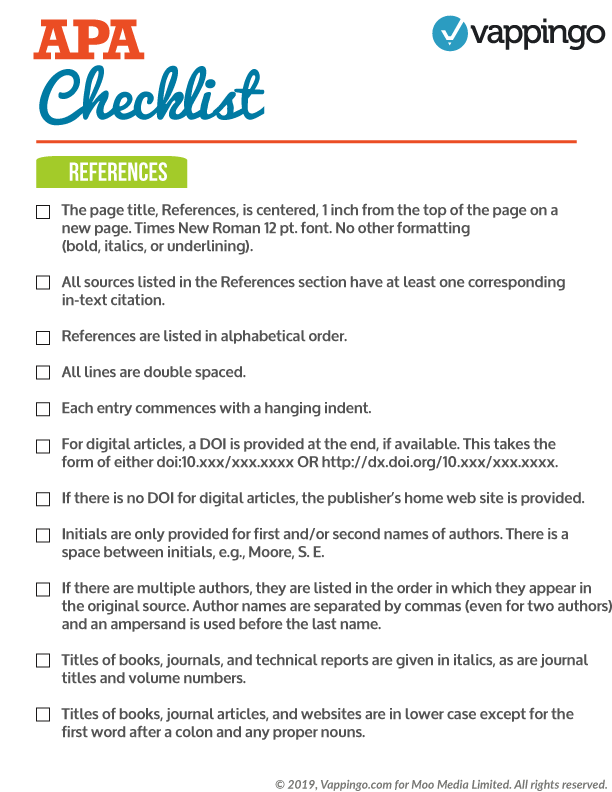
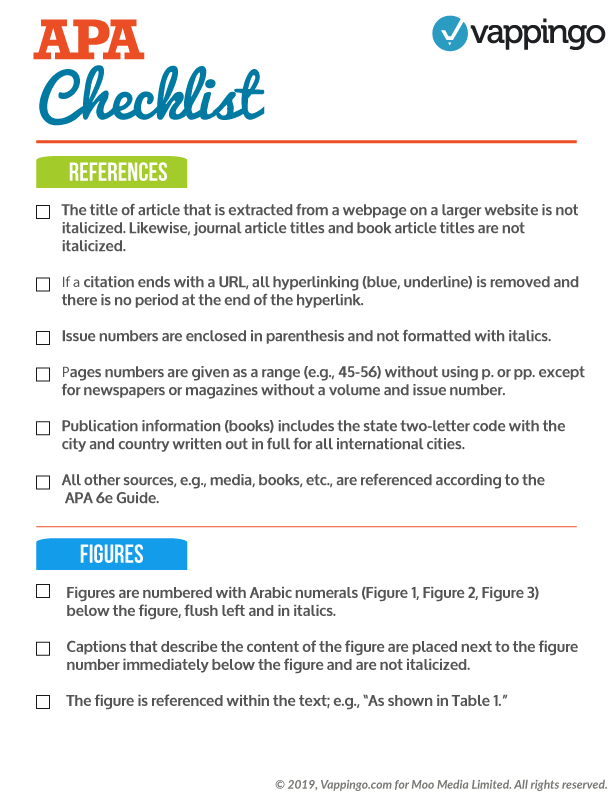
- The page title, References, is centered, 1 inch from the top of the page on a new page. Times New Roman 12 pt. font. No other formatting (bold, italics, or underlining).
- All sources listed in the References section have at least one corresponding in-text citation.
- References are listed in alphabetical order.
- All lines are double spaced.
- Each entry commences with a hanging indent. For digital articles, a DOI is provided at the end, if available. This takes the form of either doi:10.xxx/xxx.xxxx OR http://dx.doi.org/10.xxx/xxx.xxxx. If there is no DOI for digital articles, the publisher’s home web site is provided.
- Initials are only provided for first and/or second names of authors. There is a space between initials, e.g., Moore, S. E. If there are multiple authors, they are listed in the order in which they appear in the original source.
- Author names are separated by commas (even for two authors) and an ampersand is used before the last name. Titles of books, journals, and technical reports are given in italics, as are journal titles and volume numbers.
- Titles of books, journal articles, websites are in lower case except for the first word after a colon and any proper nouns.
- The title of article that is extracted from a webpage on a larger website is not italicized. Likewise, journal article titles and book article titles are not italicized.
- If a citation ends with a URL, all hyperlinking (blue, underline) is removed and there is no period at the end of the hyperlink.
- Issue numbers are enclosed in parenthesis and not formatted with italics.
- Pages numbers are given as a range (e.g., 45-56) without using p. or pp. except for newspapers or magazines without a volume and issue number.
- Publication information (books) includes the state two-letter code with the city and country written out in full for all international cities. All other sources, e.g., media, books, etc., are referenced according to the APA 7e Guide.
APA Rules: Figures
- Figures are numbered with Arabic numerals (Figure 1, Figure 2, Figure 3) below the figure, flush left and in italics.
- Captions that describe the content of the figure are placed next to the figure number immediately below the figure and are not italicized.
- The figure is referenced within the text; e.g., “As shown in Table 1.”
APA Rules: Tables
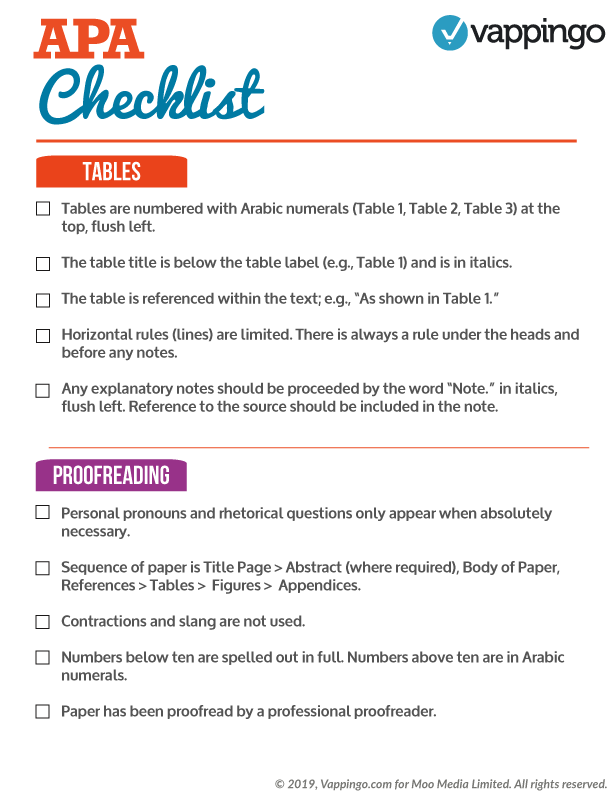
- Tables are numbered with Arabic numerals (Table 1, Table 2, Table 3) at the top, flush left.
- The table title is below the table label (e.g., Table 1) and is in italics.
- The table is referenced within the text; e.g., “As shown in Table 1.”
- Horizontal rules (lines) are limited. There is always a rule under the heads and before any notes.
- Any explanatory notes should be proceeded by the word “Note.” in italics, flush left.
- Reference to the source should be included in the note.
APA Rules: Proofreading
Of course, it isn’t enough to just follow all the rules. You need to make sure your essay or dissertation doesn’t contain any minor spelling, grammatical, or punctuation errors. If proofreading really isn’t your thing. Leave it to a professional! Check out our dissertation proofreading services. Our native-English experts will meticulously check your dissertation to make sure it doesn’t contain any errors that detract from the quality of your research.
If you do insist on proofreading your essay or dissertation for yourself. Take a look out for the following:
- Personal pronouns and rhetorical questions only appear when absolutely necessary.
- Sequence of paper is Title Page > Abstract (where required), Body of Paper, References > Tables > Figures > Appendices.
- Contractions and slang are not used.
- Numbers below ten are spelled out in full.
- Numbers above ten are in Arabic numerals.
- Paper has been proofread by a professional proofreader.
And there we have it. A complete guide to all the APA rules you need to take into consideration within academic documents in one handy little checklist. You can download a free printable PDF version of the APA checklist by clicking on the image below.

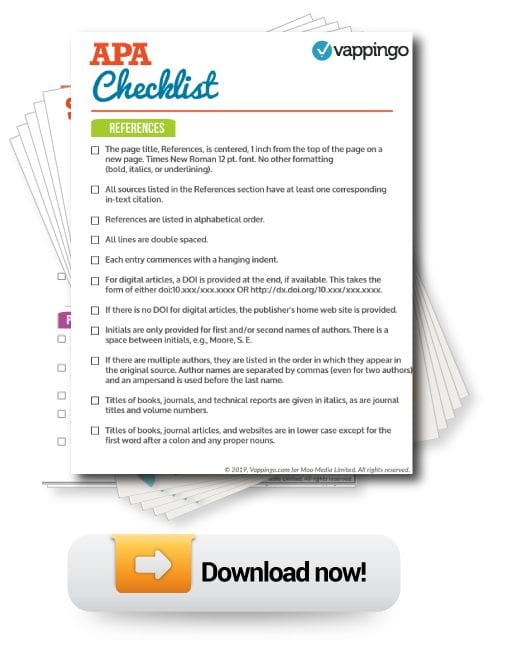
9 thoughts on “APA Checklist: A Definitive Guide to APA Rules”
Comments are closed.